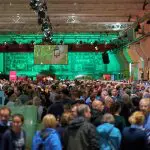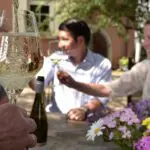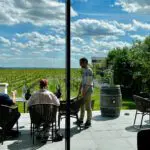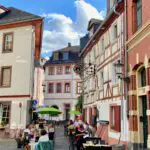
If you are interested in understanding a wine, what better way would there be than travelling and getting to see where it is growing, how it is produced and consumed? Your wine tour would lead you through the region, from the vineyard into the estate, to the cellar and eventually into the winebars, wine taverns, and restaurants where the locals consume it.
This might be getting a bit tricky if you are a fan of a very particular wine, say a La Tache from Burgundy, an Ornellaia – or in the case of German high-end – a GMax from Rheinhessen or a Scharzhofberg from Mosel (or similar status-wines). In most cases a personal visit to cult-wineries is limited to the lesser mortals of the world of wines. But, on a slightly broader scope, understanding the region where a wine is from will work out nicely, perhaps tell even more than looking at just one winery of fame. In case of the GMax for instance, it is worth exploring the surroundings of Rheinhessen. And to get a better understanding of the Schwarzhofberg, one might want to check out the upper Mosel and the Saar wine region.
The German Wine Institute (DWI) has put together a list of 52 highlights of German Wine Culture. The digital version is available online and sortable by 13 wine regions (unfortunately it is in German only). These highlights include vineyards and sights, historic buildings, villages, cellars, and wineries that have contributed or are still contributing to what wines of the specific regions are today.
For Rheinhessen the highlights include the Liebfrauenstift, Wasem’s Abbey Engelthal (now converted into a winery-cum-event-location), the Niersteiner Gloeck (Germany’s oldest Vineyard, first documented in 742) and the Kupferbergterassen (some of the world’s deepest wine cellars) in Mainz. We would wish there was inclusion of the Fleckenmauer, the fortified walls of Floersheim-Dalsheim, the village where the GMax is made. Perhaps the Trullos, too, small vineyard shelters, looking like they had been transplanted right out of Tuscany, their locations providing sweeping sights of the rolling hills of Rheinhessen
Some places listed in the DWI highlights of German Wine Culture are world famous and no-brainers for the discerning wine-traveler. Any tourist guidebook for instance would list, places like the Bremmer Calmont in Mosel (the world’s steepest vineyard), or Kloster Eberbach in Rheingau (considered the birthplace of German Riesling). But then the DWI list also include lesser known gems, that still manage to remain a bit of a secret, such as the ruins of Abbey Disibodenberg in Nahe.





All pictures (c) Deutsches Wine Institut
Complementing the list, the DWI has curated a very recommendable photographic exhibition with spectacular pictures of some of the finest spots of German Wine Culture. Following stops in China and Canada the exhibition is currently open to the public and free-of-charge till 11th of November 2017 in the city hall in Mainz, Germany’s Great Wine Capital. There is documentation in English language. The opening hours – slightly German style – are limited to week-days and morning time on Saturdays, though.
Keen on including some great stops into your next wine trip? At Bottlestops, we’ll be pleased to help you plan and take your wine tour, just get in touch.








